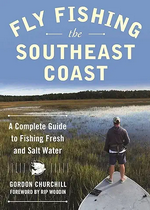Fly fishing can be expensive if you want it to be. But it is not necessary to spend big bucks. There are some things you will need to have.
-A decent fly rod, a matching reel, and matching line
-8-wt or 9-wt for saltwater- reel with a decent drag
-5-wt or 6-wt for fresh water- drag is not as essential
-Basic selection of flies:
-for saltwater: Lefty’s Deceiver, Clousers, popping bugs (fresh and salt), crab patterns, shrimp patterns, and flies known to work in the local area.
-for fresh water: caddis, mayflies, Adams, various midges, nymphs, terrestrials
-Nippers or scissors attached to a “Zinger” that has a retractable cord in it to pull the tool out of the way
-Polarized sun glasses (gray and amber) to help reduce glare so you can see the fish. I am partial to amber.
-Wide brim hat for sun protection and protection from a fly getting caught in your ear
-Forceps or pliers to remove hooks from fish
-Wax for ferrules on the rod (avoid candle wax). Wax will help hold the rod together when casting but keep the pieces from sticking when you pull them apart.
-Line cleaning equipment: Woolite is a lot cheaper than the tiny bottles of line cleaner. Avoid strong detergents!
-Side cutters for removing hooks from flesh
-Extra leader and tippet materials
-for saltwater: 50 lb. test, 40 lb. test, 30 lb. test, 20 lb. test, 15, 12, and 10 lb. test
-for fresh water: 40 lb. test, 30 lb. test, 20 lb. 12 lb. test, tippets – 0X- 6 X tippet materials
Optional equipment:
-Fishing vest/pack
-Waders and boots (see note below)
-Wading stick (essential in deeper or fast-moving water)
-Extra spools of line (extra spools for your reels are even better, though more expensive)
-Line winder for changing line
-Flats boots- but some Chuck Taylor high top tennis shoes will work
N.B. Trout live in cool to cold water so you will need waders. You will be glad if you get stocking-foot waders and not boot-foot waders which have boots attached. Boot-foot waders tend to be inexpensive but the boots do not provide adequate support for your ankles when wading or hiking. With the stocking-foot waders you get your wading boots separately (make sure you get boots 2-3 sizes larger than your regular shoe size to accommodate the very thick neoprene “stockings” that are attached to the waders. Make sure you can wiggle your toes. You may want to buy boots for hiking, too. In the past, felt-soled wading boots were essential for wading on slick rocks but concern about invasive species living in the felt and infecting other waters has led felt souls to be banned in many locations. Rubber soled wading boots with studs to screw into the rubber soles or aluminum bars to attach to the boot’s rubber soles fill the bill.
Do not bother with hip-boots. They attach to your fishing belt and have no seat- just two legs.
For really cold, wet weather, neoprene waders keep you warm, or have a better chance of doing so. I hope some of the members who grew up in northern regions will respond to this with recommendations.
Don’t forget to check out the resources of Fly Fishers International at www.flyfishersinternational.org.
Also, Google this and other topics of interest and go to YouTube for seemingly endless videos.



